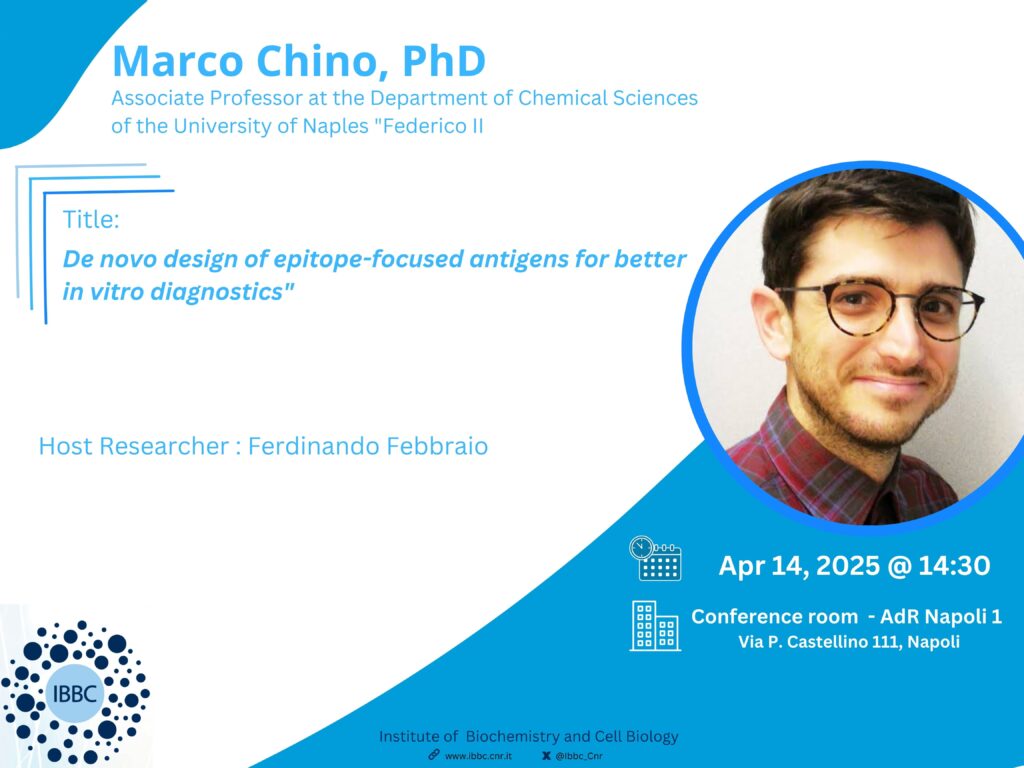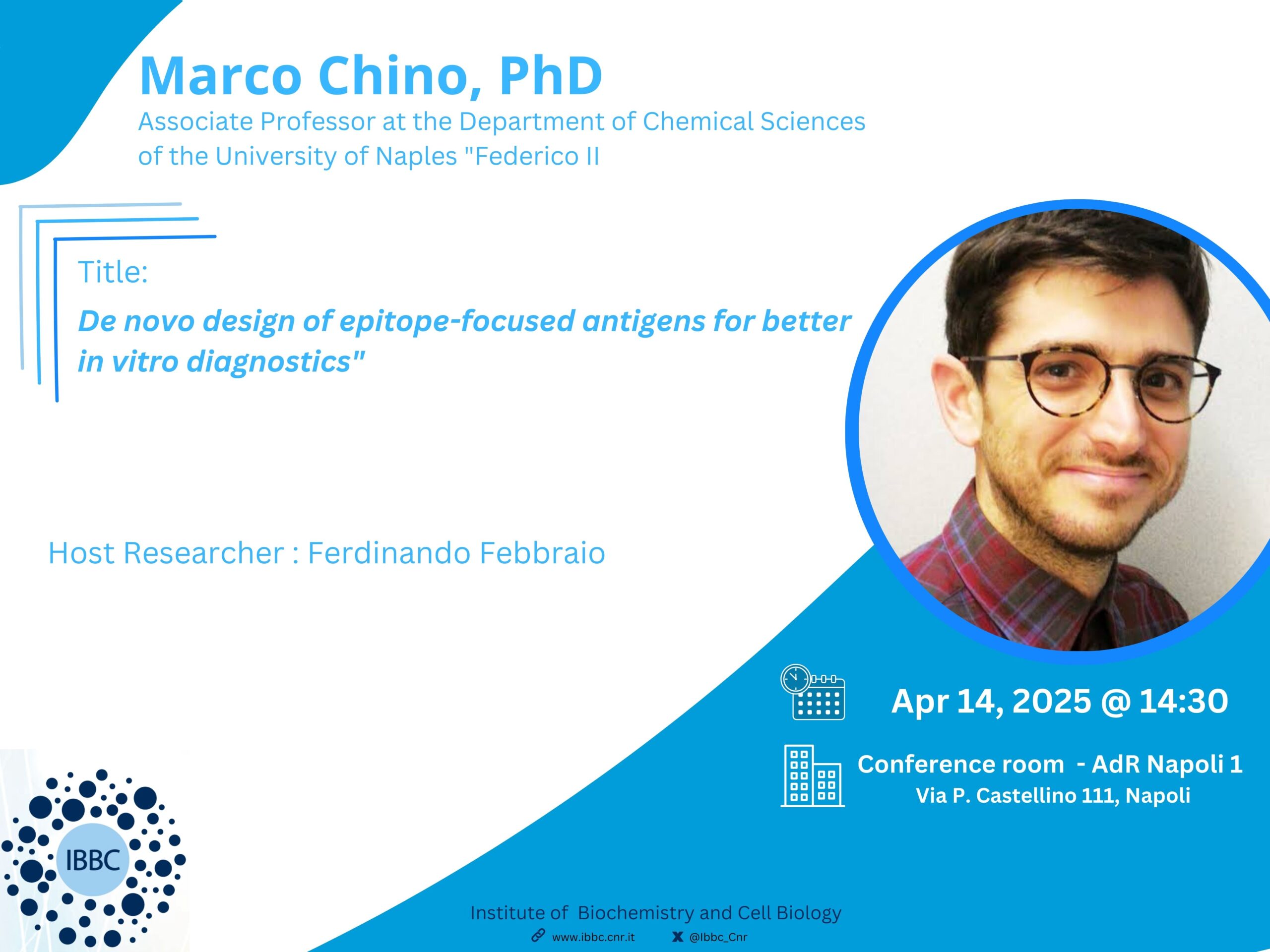- Marco Chino,PhD
University of Naples “Federico II” - Title: “De novo design of epitope-focused antigens for better in vitro diagnostics”
- Host researcher: Ferdinando Febbraio
Biosketch Prof. Marco Chino – Department of Chemical Sciences University of Naples Federico II
Prof. Marco Chino, PhD, is an Associate Professor at the Department of Chemical Sciences of the University of Naples Federico II. His group is dedicated to the de novo design of peptides, proteins and metalloproteins with controlled assembly, novel metal binding properties, in both biomedicine and catalysis. His main expertise is in computational protein design, experimental validation, structural characterization, and functional testing of metal-coordinating proteins. His scientific interests span from fundamental studies on protein folding (La Gatta et al. 2021, Maglio et al. 2021, Pirro et al. 2020, Zhang et al. 2018, Itri et al. 2018, Itri et al. 2016), to more application-oriented studies on drug delivery and nanotechnology (De Capua et al. 2024, De Capua et al. 2021, Zambrano et al., 2018), antimicrobial peptides (Oliva et al. 2020, Oliva et al. 2018, Gaglione et al. 2017), diagnostics and sensing devices (Rodrigues et al. 2022, Rodrigues et al. 2022, Hussein et al. 2020, Zambrano et al. 2020, Cetrangolo et al. 2020, Carullo et al. 2018), and artificial metalloenzymes for hydrogen production and oxidative processes (Chino et al. 2023, Pirro et al. 2023, Leone et al. 2020, Le et al. 2020, Lombardi et al. 2019, Leone et al. 2018, Vitale et al. 2015).
Abstract
De-novo protein design allows a more accurate exploration of the folding space than directed evolution and has provided remarkable benefits to several fields of medicine and biochemistry, such as in-vitro diagnostics (IVD)1. Specifically, the IVD industry still relies on antibodies due to their cheap price and established production methods. The design of de-novo antigens with high specificity can reduce the time of production of novel antibodies, while increasing their effectiveness. Thanks to the recent advances in the AI field2,3,4, the chance of success-rate of in-silico de-novo design significantly increased, particularly due to the different models available in the Rosetta suite. We present a workflow focused on the generation of small-protein scaffolds (~50AA) around a known antigen epitope to design de-novo antigens which can elicit higher immune response in host organisms. The workflow begins with a generation phase, using RFdiffusion2 to generate the backbone structure and ProteinMPNN3 to sample several sequences from these backbones. A subsequent validation phase leveraging AI folding models, as OmegaFold4 and AlphaFold5, aims to filter the sequences which are most likely folded to their original backbones. These two phases are cyclically iterated until a high rate of folding accuracy is predicted. The obtained proteins are subsequently screened in-silico to evaluate their immunogenicity6, to retain a small set of (3 to 6) designed antigens with the highest predicted values. The workflow is fully generalizable to any given epitope and, as a proof of concept, we applied this workflow to scaffold around two epitopes of HPV-16 and one epitope of SARS-CoV-2 obtaining small de-novo antigens for each epitope. For one epitope of HPV-16, the resulting set of 6 de-novo antigens is currently being screened in-vitro.
[1] Chu, A.E., Lu, T. & Huang, PS. “Sparks of function by de novo protein design”. Nat Biotechnol 42, 203–215 (2024). DOI: 10.1038/s41587-024-02133-2.
[2] Watson, J.L., Juergens, D., Bennett, N.R. et al. “De novo design of protein structure and function with RFdiffusion”. Nature 620, 1089–1100 (2023). DOI: 10.1038/s41586-023-06415-8.
[3] Dauparas J. et al. “Robust deep learning–based protein sequence design using ProteinMPNN”. Science 378,49-56(2022). DOI: 10.1126/science.add2187.
[4] Wu, R. et al. “High-resolution de novo structure prediction from primary sequence”. BioRxiv (2022). DOI: 10.1101/2022.07.21.500999.
[5] Jumper, J., Evans, R., Pritzel, A. et al. “Highly accurate protein structure prediction with AlphaFold”. Nature 596, 583–589(2021). DOI: 10.1038/s41586-021-03819-2
[6] Gainza, P., Sverrisson, F., Monti, F. et al. “Deciphering interaction fingerprints from protein molecular surfaces using geometric deep learning”. Nat Methods 17, 184–192 (2020). DOI: 10.1038/s41592-019-0666-6.

